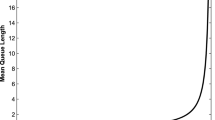Abstract
A number of independent traffic streams arrive at a queueing node which provides a finite buffer and a non-idling service at constant rate. Customers which arrive when the buffer is full are dropped and counted as overflows. We present Chernoff type bounds for mean overflow rates in the form of finite-dimensional minimization problems. The results are based on bounds for moment generating functions of buffer and bandwidth usage of the individual streams in an infinite buffer with constant service rate. We calculate these functions for regulated, Poisson and certain on/off sources. The achievable statistical multiplexing gain and the tightness of the bounds are demonstrated by several numerical examples.
Similar content being viewed by others
References
D. Botvich and N. Duffield, Large deviations, the shape of the loss curve, and economies of scale in large multiplexers, Queueing Systems 20 (1995) 293–320.
J. Cohen, The Single Server Queue, Applied Mathematics and Mechanics, Vol. 8 (North-Holland, Amsterdam, 1982), revised ed.
A. Elwalid, D. Mitra and R.H. Wentworth, A new approach for allocating buffers and bandwidth to heterogeneous regulated traffic in an ATM node, IEEE J. Selected Areas Commun. 13(6) (1995) 1115–1127.
S.N. Ethier and T.G. Kurtz, Markov Processes, Characterization and Convergence, Wiley Series in Probability and Mathematical Statistics (Wiley, New York, 1986.
B. Gnedenko and D. König, eds., Handbuch der Bedienungstheorie II (Akademie-Verlag, Berlin, 1984).
S. Golestani, Network delay analysis of a class of fair queueing algorithms, IEEE J. Selected Areas Commun. 13(6) (1995) 1057–1070.
X. Gu, K. Sohraby and D.R. Vaman, Control and Performance in Packet, Circuit and ATM Networks (Kluwer Academic, Dordrecht, 1995).
I.W. Habib and T.N. Saadawi, Multimedia traffic characteristics in broadband networks, IEEE Commun. Mag. (July 1992) 48–54.
T. Konstantopoulos and V. Anantharam, Optimal flow control schemes that regulate the burstiness of traffic, IEEE/ACM Trans. Networking 3 (1995) 423–432.
V. Kulkarni and N. Gautam, Admission control of multiclass traffic with service priorities in highspeed networks, Queueing Systems 26 (1997) 79–97.
J. Liebeherr, D.E. Wrege and D. Ferrari, Exact addmission control for networks with a bounded delay service, IEEE/ACM Trans. Networking 4(6) (1996) 885–901.
L.R. Lipsky, Queueing Theory. A Linear Algebraic Approach (Macmillan, New York, 1992).
F. Lo Presti, Z.-L. Zhang, J. Kurose and D. Towsley, Source time scale and optimal buffer/bandwidth trade-off for regulated traffic in an ATM node, in: Proc. of IEEE INFOCOM 97 (1997) pp. 675–682.
S. Rajagopal, M. Reisslein and K.W. Ross, Packet multiplexers with adversarial regulated traffic, in: Proc. of IEEE INFOCOM 98 (1998) pp. 347–355.
N.B. Shroff and M. Schwartz, Improved loss calculations at an ATM multiplexer, IEEE/ACM Trans. Networking 6(4) (1998) 411–421.
Author information
Authors and Affiliations
Rights and permissions
About this article
Cite this article
Majewski, K. Chernoff bounds for mean overflow rates. Queueing Systems 34, 301–326 (2000). https://doi.org/10.1023/A:1019169422381
Issue Date:
DOI: https://doi.org/10.1023/A:1019169422381




